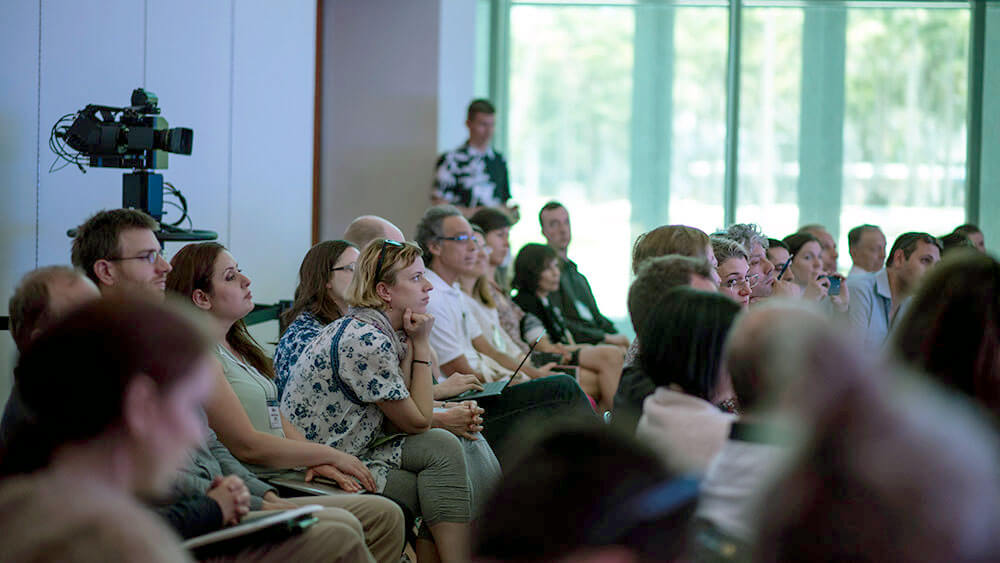
Attendees are all ears at the 2018 NPAPW conference at the New World Center in Miami Beach, Florida. (Phillip Pessar/Creative Commons)
The Network Performing Arts Production Workshops (NPAPWS) unites musicians, academic administrators, technology developers, and staff members from performing arts venues to understand how new technologies can revolutionize long-distance learning and collaboration. In 2018, the program welcomed 80 participants from 28 countries to the New World Center, an immersive concert hall and arts instruction laboratory in Miami Beach, Florida.
The venue felt familiar for many NPAPWS regulars — the workshops started there in 2003. NPAPWS is part of Internet2, a community that operates the nation’s fastest research and education network, so NPAPWS’ connections are “around 100 times faster than commercial internet,” Craig Hall, vice president for communications for the New World Symphony, told Convene during a site visit of the venue.
New World Symphony — which prepares music program graduates for leadership roles in orchestras and ensembles around the world — calls New World Center home. “Many universities have access to the same network,” Hall said, “so we started this annual conference to teach others around the world about it and help explore the possibilities.”
Since 2008, the program has rotated every other year between the New World Center and a European arts venue. Internet2, which also includes corporations, public education networks, and government agencies, pro- duces the conference with the goal of helping participants understand how to leverage connectivity to unite performers, students, and creative minds — no matter where they are located.
The 2019 event will be April 2–4 at Academy of the Performing Arts in Prague, Czech Republic.
Beyond Bandwidth
NPAPWS attracts leaders from such renowned institutions as the Royal College of Music in London, Berklee College of Music in Boston, and the University of Music and Performing Arts Vienna. The conversation focuses on the tools and technologies that are reshaping the way that parties in different places can transmit high-quality video and audio. Some of the tutorials may be over the heads of average internet users — unless Nimbra, JackTrip, Ultragrid, or MVTP ring a bell. But the program also includes a series of candid sessions called “What the Hell Was That?” — lightning talks, limited to 10 minutes, for NPAPWS attendees to share successes and failures from their own uses of the technologies.
Why We Like It
Performers don’t always have the budget to travel to play face-to-face in the same studio or concert hall, but uniting their instruments and voices in different locations isn’t as simple as plugging in the right cable. Skype, Zoom, FaceTime, and other consumer video applications cannot provide the delay-free experience that is essential to composition. Latency issues can make rehearsing or recording with someone far away impossible, and some remote areas may lack the appropriate networks. NPAPWS helps solve those challenges, sending attendees home with the know-how to unlock a new level of creativity — like live performances that include musicians in Prague, dancers in Miami and Copenhagen, and a visual artist in Barcelona, one of the projects that emerged from NPAPWS.
Those collaborations are exciting, but what makes NPAPWS strike a chord with us is seeing the impact of these technologies extend outside of traditional theaters and already-established recording studios. Consider, for example, the public library in Chattanooga, Tennessee, which was a presenter at the 2017 NPAPWS. Anyone with a library card can reserve time in the library’s state-of-the-art recording studio, where young musicians can fuel their creative ambitions and record with others around the world.
